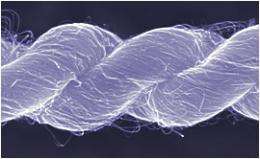Race for Superconductors Shrinks to Nanoscale

(PhysOrg.com) -- A team of researchers from UT Dallas, Clemson University and Yale University are using science on the nanoscale to address one of the most elusive challenges in physics - the discovery of room-temperature superconductivity. With that as the ultimate goal, the team is working to develop superconducting wires made from nanotubes that carry high currents at the temperature of liquid nitrogen, or higher.
With a $3 million research grant from the Air Force Office of Scientific Research (AFOSR), the team has embarked on a five-year project to invent new superconducting wires based on highly engineered nanomaterials, each component thousands of times smaller than a human hair. Such wires would be used for applications ranging from magnets for Magnetic Resonance Imaging to replacing energy-wasting copper in power transmission lines.
While traditional copper wires are highly conductive, they lose power through resistance, which translates into wasted energy. Superconductive materials transmit power without resistance, but they have to be cooled to low temperatures.
“The year 2011 marks 100 years since superconductivity was discovered,” said Dr. Anvar Zakhidov, one of the researchers on the project and an associate director of the Alan G. MacDiarmid NanoTech Institute. “Still, the problem of finding a room temperature superconductor has not been solved, and present high temperature superconductors become non-superconducting when currents are moderate. Also, modern high temperature superconducting materials are too brittle, expensive and deficient in electronic properties for wide-scale application. We hope to overcome those limitations by fabricating wires from nanotubes, using carbon nanotubes or other nanotubes enhanced by atoms like boron, nitrogen or sulfur.”
According to Zakhidov, who is a professor of physics, as much as 30 percent of electrical energy can be lost as heat when electricity travels through power lines. Superconducting materials promise enormous environmental and energy savings.
Under the leadership of Zakhidov and Dr. Ray Baughman, director of the NanoTech Institute, the team at the institute has already pioneered methods to assemble nanomaterials into yarns.
“Making superconducting wires and cables from nanofibers and nanoparticles presents special challenges that go beyond the discovery of new superconductors,” Baughman said. “For example, for each pound of superconducting wire, it may be necessary to assemble more than 3 billion miles of individual nanotubes—and the goal is to achieve this assembly at commercially useful rates. For this task, we are inventing radically new methods for making superconducting wires.”
Dr. Lisa Pfefferle, professor of chemical engineering at Yale University and member of the research team, is experimenting with new types of nanofibers that have been synthesized by her team using elements like boron.
Team member Dr. Apparao Rao, professor of physics at Clemson University, has already produced superconducting nanotubes by a process called pulsed laser ablation. The process results in carbon nanotubes “doped” with boron that superconduct at higher temperatures than other carbon based materials—but still at relatively low temperatures.
Dr. Myron Salamon, dean of the School of Natural Sciences and Mathematics, will evaluate the team’s new superconductors to test the maximum temperature of superconductivity as a function of current and power transmitted, which is a crucial factor for using these materials in power systems.
“There’s always been a sense that we can enhance superconductivity by using lighter materials,” Salamon said. “Wires made from ultra-light nanotubes can allow atoms to vibrate easily, which helps with superconductivity. There’s good evidence that carbon-based materials, like dopant modified carbon nanotubes, might make good superconductors.”
Five research grants were awarded to spur development of practical high temperature superconductors. The grants are administered through the AFOSR by Project Manager Dr. Harold Weinstock, who has helped pioneer and support many other important discoveries in physics. According to Zakhidov, other universities in the collaborative superconductor race include the University of Houston, the University of Maryland, the University of California, San Diego and Stanford University.
Provided by UT Dallas
















